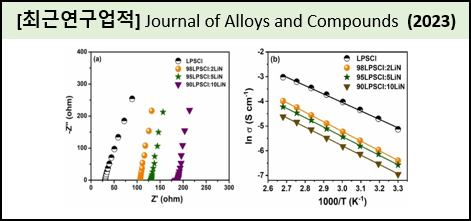|
Abstract
(superscript and subscript cannot be allowed.) |
Lithium dendrite growth and incompatibility with high cell voltage cathode materials is one of the serious issues behind solid-state batteries because it deteriorates the electrochemical performances. To avert these issues, we emphasize the blending of Li3N/Li3YCl6 with the Li6PS5Cl (LPSCl) system to tackle the aforementioned issues. The (100-x) LPSCl:x(Li3N/Li3YCl6) (x = 0, 2, 5 and 10) solid electrolyte composition is synthesized by using the ball milling process. The phase purity analysis reveals that prepared composition still exists in argyrodite structure after milling of two solid electrolytes. The electrochemical impedance measurement indicates that the prepared composition exhibits an ionic conductivity values over 1 mS cm−1 at lower concentration of Li3N/Li3YCl6 (x = 2 and 5). The critical current density measurement confirms the 98LPSCl: 2Li3N composition exhibits a higher critical current density of 0.55 mA cm−2 than the other compositions. Moreover, the assembled battery using 98LPSCl: 2Li3N delivers the discharge capacity of 179.1 mAh g−1 with a capacity retention of 92.3% over 100 cycles and also maintains a high reversible capacity of 131 mAh g−1 at 2 C rate. Finally, the coulombic efficiency of the solid-state battery increases to 74.9% by using 95LPSCl:5Li3YCl6 composition as an interlayer between the electrode and the electrolyte interface. |

